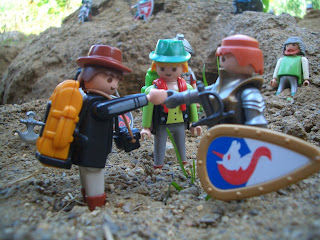Today we are visitin Kaufungen, a smal town nex to Kassel.
Kaufungen has a nice
museum.
It is located in this blue and white old half-timber house.
Unfortunately it was closed.
Inside of the frontgarden is a big bug house and a huge herb garden. Besides the main house is a smaler half-timber house. There is a seminar hous for children to work like as it used to be.
In the northan part of Hesse are a lot of hiking path. Here are two signs of hiking path and a resting area for hikers. We took a smal brake and enjoyed the nice summer day...
Kaufungen is a 1000 years old town. Here are a long old stables.
In 1017 Henry II, Holy Roman Emperor and his queen Kunigunde of Luxemburg founded Kaufungen Abbey, a Benedictine
convent, perched on the steep edge of the Losse valley above what is
now the centre of Oberkaufungen. Upon the death of her husband, Kunigunde entered the convent, and lived there until her death in 1033
or 1039. The Reformation brought the closure of the convent in 1527, but the large church (the Stiftskirche)
is still standing and in use as a parish church today. At various
points in its history, Kaufungen has been a local centre for mining,
glass-making, charcoal burning, forestry and paper manufacture.
The farming settlement of Niederkaufungen, situated slightly
downriver where the narrow Losse valley begins to open out into the
wide, flat plain of the Fulda,
is of more recent origin. In 1970 the villages of Nieder- and
Oberkaufungen formally merged to form the present municipality. Since
1974, the Stiftskirche has played host to the Kaufunger Konzerte series of classical music concerts. (Wikipedia)
This is the Stiftskirche.
This is a memorial stone for Kunigunde.
Next to the church is a sign with a fairy-tale written on it. The region of Kassel and Kaufungen are the homeland of the Grimm Brothers.
This is the inner courtyard of the Stiftshof next to the Stiftskirche. At summertime here takes place a lot of concerts and other events.
Behind the Stiftshof is a nice old garden. We make a smal brake and enjoyed the natur.
Here was the old cloister.
This is a portrait of Kunigunde
This is the info board under Kunigundes portrait.
Do you finde us sitting on the funny door of the cloister.
This is a beautiful traditional hand-carved door.
Have a look at the nice town Kaufungen. There are a lot of old half-timber houses.
Kaufungen is build nex to the Losse a smal nice river
Also next to the Losse is also a sign with a fairy-tale.
In front of the townhall is a interesting monument. It shows four people which symbolize the old and the new citizen of the two neighbourhoods of Kaufungen named Oberkaufungen and Niederkaufunegn.






.JPG)
.JPG)
































